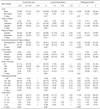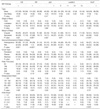1. Kuhl CK, Mielcareck P, Klaschik S, Leutner C, Wardelmann E, Gieseke J, et al. Dynamic breast MR imaging: are signal intensity time course data useful for differential diagnosis of enhancing lesions? Radiology. 1999. 211:101–110.
2. Orel SG. Differentiating benign from malignant enhancing lesions identified at MR imaging of the breast: are time-signal intensity curves an accurate predictor? Radiology. 1999. 211:5–7.
3. Mussurakis S, Gibbs P, Horsman A. Peripheral enhancement and spatial contrast uptake heterogeneity of primary breast tumors: quantitative assessment with dynamic MRI. J Comput Assist Tomogr. 1998. 22:35–46.
4. Szabó BK, Aspelin P, Kristoffersen Wiberg M, Tot T, Bone B. Invasive breast cancer: correlation of dynamic MR features with prognostic factors. Eur Radiol. 2003. 13:2425–2435.
5. Jinguji J, Kajiya Y, Kamimura K, Nakajo M, Sagara Y, Takahama T, et al. Rim enhancement of breast cancers on contrast-enhanced MR imaging: relationship with prognostic factors. Breast Cancer. 2006. 13:64–73.
6. Teifke A, Behr O, Schmidt M, Victor A, Vomweg TW, Thelen M, et al. Dynamic MR imaging of breast lesions: correlation with microvessel distribution pattern and histologic characteristics of prognosis. Radiology. 2006. 239:351–360.
7. Mussurakis S, Buckley DL, Horsman A. Dynamic MR imaging of invasive breast cancer: correlation with tumor grade and other histologic factors. Br J Radiol. 1997. 70:446–451.
8. Bone B, Aspelin P, Bronge L, Veress B. Contrast-enhanced MR imaging as a prognostic indicator of breast cancer. Acta Radiol. 1998. 39:279–284.
9. Stomper PC, Herman S, Klippenstein DL, Winston JS, Edge SB, Arredondo MA, et al. Suspect breast lesions: findings at dynamic gadolinium-enhanced MR imaging correlated with mammographic and pathologic features. Radiology. 1995. 197:387–395.
10. Fischer U, Kopka L, Brinck U, Korabiowska M, Schauer A, Grabbe E. Prognostic value of contrast-enhanced MR mammography in patients with breast cancer. Eur Radiol. 1997. 7:1002–1005.
11. Tuncbilek N, Karakas HM, Okten OO. Dynamic magnetic resonance imaging in determining histopathological prognostic factors of invasive breast cancers. Eur J Radiol. 2005. 53:199–205.
12. American College of Radiology. Breast Imaging Reporting and Data System- Magnetic Resonance Imaging. 2003. 1st ed. Reston, VA: American College of Radiology.
13. Lee SH, Cho N, Chung HK, Kim SJ, Cha JH, Cho KS, et al. Breast MR imaging: correlation of high resolution dynamic MR findings with prognostic factors. J Korean Radiol Soc. 2005. 52:355–361. (Korean).
14. Elston CW, Ellis IO, Pinder SE. Pathologic prognostic factors in breast cancer. Crit Rev Oncol Hematol. 1999. 31:209–223.
15. Elston CW, Ellis IO. Pathological prognostic factors in breast cancer. I. The value of histological grade in breast cancer: experience from a large study with long-term follow-up. Histopathology. 1991. 19:403–410.
16. Stavros AT, Thickman D, Rapp CL, Dennis MA, Parker SH, Sisney GA. Solid breast nodule: use of sonography to distinguish between benign and malignant lesions. Radiology. 1995. 196:123–134.
17. Stavros AT. Stavros AT, editor. Malignant solid breast nodules: specific type. Breast ultrasound. 2004. 1st ed. Philadelphia: Lippincott Williams & Wilkins;597–688.
18. Buadu LD, Murakami J, Murayama S, Hashiguchi N, Sakai S, Masuda K, et al. Breast lesions: correlation of contrast medium enhancement patterns on MR images with histopathologic findings and tumor angiogenesis. Radiology. 1996. 200:639–649.
19. Buckley DL, Drew PJ, Mussurakis S, Monson JR, Horsman A. Microvessel density of invasive breast cancer assessed by dynamic Gd-DTPA enhanced MRI. J Magn Reson Imaging. 1997. 7:461–464.
20. Matsubayashi R, Matsuo Y, Edakuni G, Satoh T, Tokunaga O, Kudo S. Breast masses with peripheral rim enhancement on dynamic contrast-enhanced MR images: correlation of MR findings with histologic features and expression of growth factors. Radiology. 2000. 217:841–848.
21. Stomper PC, Herman S, Klippenstein DL, Winston JS, Budnick RM, Stewart CC. Invasive breast carcinoma: analysis of dynamic magnetic resonance imaging enhancement features and cell proliferative activity determined by DNA S-phase percentage. Cancer. 1996. 77:1844–1849.
22. Heywang-Kobrunner SH. Contrast enhanced magnetic resonance imaging of the breast. Invest Radiol. 1994. 29:94–104.







 PDF
PDF ePub
ePub Citation
Citation Print
Print




 XML Download
XML Download